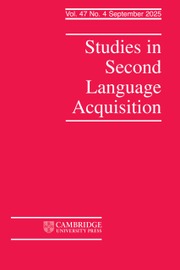Article contents
Grammatically Judgments and Second Language Acquisition
Published online by Cambridge University Press: 07 November 2008
Extract
This article takes a critical look at grammaticality judgment tasks in second language acquisition research. It begins by examining the theoretical assumptions that underlie grammaticality judgment tasks, pointing out that previous studies have reported considerable differences between the results obtained from grammaticality judgment tasks and from other, production-oriented tasks. A description of the design features of grammaticality judgment tasks that have been used to date is then provided. There follows an account of a small-scale study designed to investigate the nature of learner judgments. Twenty-one adult advanced Chinese learners of English were asked to judge sentences designed to test their knowledge of dative alternation. The results indicated that the learners rarely used the “not sure” option in the test. Eight of these subjects were then administered a reduced version of the original test as a think-aloud task 1 week later. The results showed that these learners were inconsistent in 22.5% of their judgments. The think-aloud protocols showed that they resorted to a variety of strategies in making judgments. The article concludes by arguing that grammaticality judgment tasks elicit a particular kind of performance that needs to be understood much more thoroughly before it is used as a basis for investigating second language acquisition.
Information
- Type
- Articles
- Information
- Copyright
- Copyright © Cambridge University Press 1991
References
REFERENCES
- 82
- Cited by

